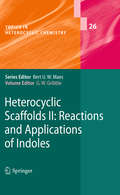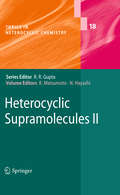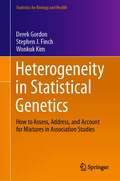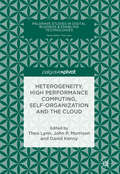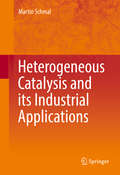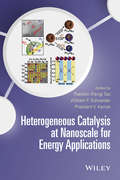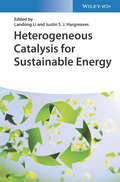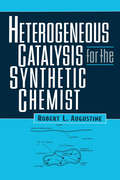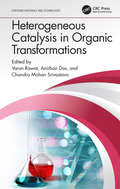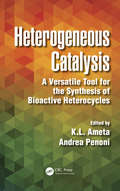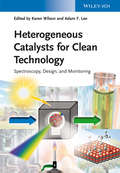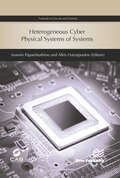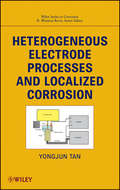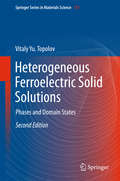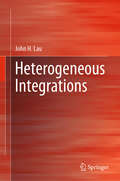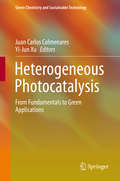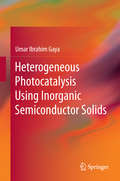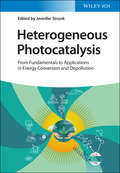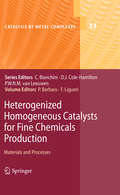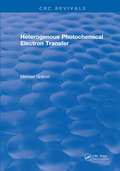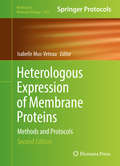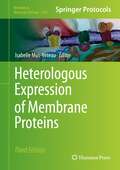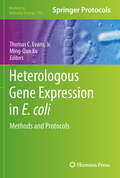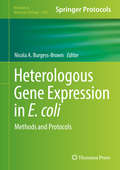- Table View
- List View
Heterocyclic Scaffolds II:
by Gordon W. GribbleRichard J. Sundberg Electrophilic Substitution Reactions of Indoles Tara L.S. Kishbaugh Reactions of Indole with Nucleophiles Erin Pelkey Metalation of Indole Jie Jack Li Gordon W. Gribble Metal-Catalyzed Cross-Coupling Reactions for Indoles Jeanese C. Badenock Radical Reactions of Indole Fariborz Firooznia Robert F. Kester Steven J. Berthel [2+2], [3+2] and [2+2+2] Cycloaddition Reactions of Indole Derivatives Robert F. Kester Steven J. Berthel Fariborz Firooznia [4+2] Cycloaddition Reactions of Indole Derivatives Jonathon S. Russel Oxindoles and Spirocyclic Variations: Strategies for C3 Functionalization Liangfeng Fu Advances in the Total Syntheses of Complex Indole Natural Products
Heterogeneity in Statistical Genetics: How to Assess, Address, and Account for Mixtures in Association Studies (Statistics for Biology and Health)
by Derek Gordon Stephen J. Finch Wonkuk KimHeterogeneity, or mixtures, are ubiquitous in genetics. Even for data as simple as mono-genic diseases, populations are a mixture of affected and unaffected individuals. Still, most statistical genetic association analyses, designed to map genes for diseases and other genetic traits, ignore this phenomenon. In this book, we document methods that incorporate heterogeneity into the design and analysis of genetic and genomic association data. Among the key qualities of our developed statistics is that they include mixture parameters as part of the statistic, a unique component for tests of association. A critical feature of this work is the inclusion of at least one heterogeneity parameter when performing statistical power and sample size calculations for tests of genetic association. We anticipate that this book will be useful to researchers who want to estimate heterogeneity in their data, develop or apply genetic association statistics where heterogeneity exists, and accurately evaluate statistical power and sample size for genetic association through the application of robust experimental design.
Heterogeneity, High Performance Computing, Self-Organization and the Cloud (Palgrave Studies In Digital Business And Enabling Technologies Ser.)
by David Kenny Theo Lynn John P. MorrisonThis book is open access under a CC BY NC ND license. It addresses the most recent developments in cloud computing such as HPC in the Cloud, heterogeneous cloud, self-organising and self-management, and discusses the business implications of cloud computing adoption. Establishing the need for a new architecture for cloud computing, it discusses a novel cloud management and delivery architecture based on the principles of self-organisation and self-management. This focus shifts the deployment and optimisation effort from the consumer to the software stack running on the cloud infrastructure. It also outlines validation challenges and introduces a novel generalised extensible simulation framework to illustrate the effectiveness, performance and scalability of self-organising and self-managing delivery models on hyperscale cloud infrastructures. It concludes with a number of potential use cases for self-organising, self-managing clouds and the impact on those businesses.
Heterogeneous Catalysis and its Industrial Applications
by Martin SchmalThis book aims to introduce the basic concepts involved in industrial catalytic processes. It is profusely illustrated with experimental results with the main objective of guiding how to select a suitable catalyst for specific processes. The book is divided in two parts. In the first part the basic concepts are addressed, regarding the existing theories, activity patterns and adsorption-desorption phenomena. In the second part the key experimental methods for the physicochemical characterization of catalysts are presented, as well as the currently used catalyst pre and post treatments. The last chapter describes some important in situ characterization techniques (e. g. XPS and TEM) and surface model patterns related to surface modifications occurring during the reaction. Thoroughly illustrated with microscopy images, spectroscopy data and schematics of reaction mechanisms, the book provides a powerful learning tool for students in undergraduate and graduate level courses on the field of catalysis. Exercises and resolved problems are provided, as well as experimental procedures to support laboratory classes. Furthermore, the content is presented in a carefully chosen sequence, reflecting the 30 year teaching experience of the author. The author, Professor Martin Schmal, sees the present book as a way of conveying basic knowledge needed for the development of more efficient catalysts (i. e. nanostructured materials) and novel industrial chemical processes in the fields of environmental chemistry, fine chemistry, hydrotreating of heavy oils, hydrogen production and biomass processing.
Heterogeneous Catalysis at Nanoscale for Energy Applications
by Prashant V. Kamat Franklin Feng Tao William F. SchneiderThis book presents both the fundamentals concepts and latest achievements of a field that is growing in importance since it represents a possible solution for global energy problems. It focuses on an atomic-level understanding of heterogeneous catalysis involved in important energy conversion processes. It presents a concise picture for the entire area of heterogeneous catalysis with vision at the atomic- and nano- scales, from synthesis, ex-situ and in-situ characterization, catalytic activity and selectivity, to mechanistic understanding based on experimental exploration and theoretical simulation.The book:Addresses heterogeneous catalysis, one of the crucial technologies employed within the chemical and energy industriesPresents the recent advances in the synthesis and characterization of nanocatalysts as well as a mechanistic understanding of catalysis at atomic level for important processes of energy conversionProvides a foundation for the potential design of revolutionarily new technical catalysts and thus the further development of efficient technologies for the global energy economyIncludes both theoretical studies and experimental explorationIs useful as both a textbook for graduate and undergraduate students and a reference book for scientists and engineers in chemistry, materials science, and chemical engineering
Heterogeneous Catalysis for Sustainable Energy
by Landong LiHeterogeneous Catalysis for Sustainable Energy Explore the state-of-the-art in heterogeneous catalysis In Heterogeneous Catalysis for Sustainable Energy, a team of distinguished researchers delivers a comprehensive and cutting-edge treatment of recent advancements in energy-related catalytic reactions and processes in the field of heterogeneous catalysis. The book includes extensive coverage of the hydrogen economy, methane activation, methanol-to-hydrocarbons, carbon dioxide conversion, and biomass conversion. The authors explore different aspects of the technology, like reaction mechanisms, catalyst synthesis, and the commercial status of the reactions. The book also includes: A thorough introduction to the hydrogen economy, including hydrogen production, the reforming of oxygen-containing chemicals, and advances in Fischer-Tropsch Synthesis Comprehensive explorations of methane activation, including steam and dry reforming of methane and methane activation over zeolite catalysts Practical discussions of alkane activation, including cracking of hydrocarbons to light olefins and catalytic dehydrogenation of light alkanes In-depth examinations of zeolite catalysis and carbon dioxide as C1 building block Perfect for catalytic, physical, and surface chemists, Heterogeneous Catalysis for Sustainable Energy also belongs in the libraries of materials scientists with an interest in energy-related reactions and processes in the field of heterogeneous catalysis.
Heterogeneous Catalysis for the Synthetic Chemist
by Robert L. AugustineThis work delineates the effect of different reaction variables on the outcome of heterogeneously catalyzed reactions, and explains how to optimize the product yield of specific compounds. Metal catalysis, simple and complex oxides, zeolites and clays are discussed, both as catalysts and as potential supports for catalytically active metals.
Heterogeneous Catalysis in Organic Transformations (Emerging Materials and Technologies)
by Anirban Das Varun Rawat Chandra Mohan SrivastavaAs the broad challenges around energy and the environment have become the focus of much research, scientists and experts have dedicated their efforts to developing more active and selective catalytic systems for key chemical transformations. For many decades environmentally viable protocols for the synthesis of fine chemicals have been the crux of academic and industrial research. Heterogeneous Catalysis in Organic Transformations serves as an overview of this work, providing a complete description of role of heterogeneous catalysis in organic transformations and offering a review of the current and near future technologies and applications. Discusses the fundamentals of catalysis and compares the advantages and disadvantages of different types of catalyst systems Examines oxide nanoparticles and noble metal nanoparticles Consider organometallic compounds, solid-supported catalysts, and mesoporous materials Describes recent advances in metal-based heterogeneous catalysts and new reactions with possible mechanistic pathways Providing a comprehensive review of heterogeneous catalysis from the basics through recent advances, this book will be of keen interest to undergraduates, graduates, and researchers in chemistry, chemical engineering, and associated fields.
Heterogeneous Catalysis: A Versatile Tool for the Synthesis of Bioactive Heterocycles
by K.L. Ameta Ph.D. Andrea PenoniFor more than a century, bioactive heterocycles have formed one of the largest areas of research in organic chemistry. They are important from a biological and industrial point of view as well as to the understanding of life processes and efforts to improve the quality of life. Heterogeneous Catalysis: A Versatile Tool for the Synthesis of Bioactiv
Heterogeneous Catalysts for Clean Technology
by Adam F. Lee Karen WilsonReactive, but not a reactant. Heterogeneous catalysts play an unseen role in many of today's processes and products. With the increasing emphasis on sustainability in both products and processes, this handbook is the first to combine the hot topics of heterogeneous catalysis and clean technology.It focuses on the development of heterogeneous catalysts for use in clean chemical synthesis, dealing with how modern spectroscopic techniques can aid the design of catalysts for use in liquid phase reactions, their application in industrially important chemistries - including selective oxidation, hydrogenation, solid acid- and base-catalyzed processes - as well as the role of process intensification and use of renewable resources in improving the sustainability of chemical processes. With its emphasis on applications, this book is of high interest to those working in the industry.
Heterogeneous Cyber Physical Systems of Systems
by Alkis Hatzopoulos Loannis PapaefstathiouCyber-physical systems are the natural extension of the so-called “Internet of Things”. They are “systems of collaborating computational elements controlling physical entities”. Cyber Physical Systems of Systems (CPSoS) are considered “The Next Computing Revolution” after Mainframe computing (60’s-70’s), Desktop computing & Internet (80’s-90’s) and Ubiquitous computing (00’s); because all aspects of daily life are rapidly evolving towards humans interacting amongst themselves as well as their environment via computational devices (often mobile), and because in most cases systems will employ their computational capabilities to interact amongst themselves.CPSoS enable the physical world to merge with the cyber one. Using sensors, the embedded systems monitor and collect data from physical processes, such as the steering of a vehicle, energy consumption or human health functions. The systems are networked making the data globally available. CPSoS make it possible for software applications to directly interact with events in the physical world, for example to measure and react to changes in blood pressure or peaks in energy consumption. Embedded hardware and software systems crucially expand the functionality and competitiveness of vehicles, aircraft, medical equipment, production plants and household appliances. Connecting these systems to a virtual environment of globally networked services and information systems opens completely new areas of innovation and novel business platforms.Future CPSoS will have many sophisticated, interconnected parts that must instantaneously exchange, parse, and act on detailed data in a highly coordinated manner. Continued advances in science and engineering will be necessary to enable advances in design and development of these complex systems.
Heterogeneous Electrode Processes and Localized Corrosion
by R. Winston Revie Yongjun Mike TanSheds new light on the significance of electrode inhomogeneity and electrochemical heterogeneityA major contribution to the field of electrochemistry, this book--based on a thorough review of the literature and author Yongjun Tan's twenty years of pioneering research--examines electrochemical heterogeneity and its effects on non-uniform electrode processes. The book focuses on localized corrosion, uneven electrodeposition, and non-uniform electrodissolution. Readers will learn all the core fundamentals, experimental methods, and engineering aspects of localized corrosion and other important heterogeneous electrode processes. In particular, readers will learn core methods to quickly calculate corrosion rates and study electrode inhomogeneity and electrochemical heterogeneity.Heterogeneous Electrode Processes and Localized Corrosion begins with a review of homogeneous electrode models and uniform corrosion measurements and then explores probing electrode inhomogeneity, electrochemical heterogeneity, and localized corrosion. Next, the book examines:Visualizing localized corrosion using electrochemically integrated multi-electrode arraysMeasuring thermodynamic and kinetic parameters of localized corrosion processesCharacterizing inhomogeneity and localized corrosion on coated electrode surfacesDesigning experiments to study localized corrosion and its inhibition in inhomogeneous mediaSensing localized electrodeposition and electrodissolutionExploring versatile heterogeneous electrode processesThroughout the book, there are case studies with maps that illustrate key aspects of heterogeneous electrode processes. In addition, the author provides plenty of examples that enable readers to fully grasp core concepts of electrochemical heterogeneity and its relationship to non-uniform electrode processes.Reviewing the experimental findings presented in this book, electrochemists will gain a better appreciation and understanding of the fundamental significance of electrode inhomogeneity and electrochemical heterogeneity.
Heterogeneous Ferroelectric Solid Solutions: Phases And Domain States (Springer Series in Materials Science #151)
by Vitaly Yu. TopolovThis book systematizes data on the heterophase states and their evolution in perovskite-type ferroelectric solid solutions. It also provides a general interpretation of heterophase and domain structures on changing temperature, composition or electric field, as well as the complete analysis of interconnections domain structures, unit-cell parameters changes, heterophase structures and stress relief. The description of numerous examples of heterophase states in lead-free ferroelectric solid solutions is also included. Domain state–interface diagrams contribute to the interpretation of heterophase states in perovskite-type ferroelectric solid solutions and describe the stress relief in the presence of polydomain phases, the behavior of unit-cell parameters of coexisting phases, the effect of external electric field etc. This 2nd edition generalizes the results on the heterophase ferroelectric solid solutions and the stress relief and presents new results on heterophase/domain structures and phase contents in lead-free ferroelectric solid solutions.
Heterogeneous Integrations
by John H. LauHeterogeneous integration uses packaging technology to integrate dissimilar chips, LED, MEMS, VCSEL, etc. from different fabless houses and with different functions and wafer sizes into a single system or subsystem. How are these dissimilar chips and optical components supposed to talk to each other? The answer is redistribution layers (RDLs). This book addresses the fabrication of RDLs for heterogeneous integrations, and especially focuses on RDLs on: A) organic substrates, B) silicon substrates (through-silicon via (TSV)-interposers), C) silicon substrates (bridges), D) fan-out substrates, and E) ASIC, memory, LED, MEMS, and VCSEL systems. The book offers a valuable asset for researchers, engineers, and graduate students in the fields of semiconductor packaging, materials sciences, mechanical engineering, electronic engineering, telecommunications, networking, etc.
Heterogeneous Photocatalysis
by Juan Carlos Colmenares Yi-Jun XuThe book explains the principles and fundamentals of photocatalysis and highlights the current developments and future potential of the green-chemistry-oriented applications of various inorganic, organic, and hybrid photocatalysts. The book consists of eleven chapters, including the principles and fundamentals of heterogeneous photocatalysis; the mechanisms and dynamics of surface photocatalysis; research on TiO2-based composites with unique nanostructures; the latest developments and advances in exploiting photocatalyst alternatives to TiO2; and photocatalytic materials for applications other than the traditional degradation of pollutants, such as carbon dioxide reduction, water oxidation, a complete spectrum of selective organic transformations and water splitting by photocatalytic reduction. In addition, heterogeneized polyoxometalate materials for photocatalytic purposes and the proper design of photocatalytic reactors and modeling of light are also discussed. This book appeals to a wide readership of the academic and industrial researchers and it can also be used in the classroom for undergraduate and graduate students focusing on heterogeneous photocatalysis, sustainable chemistry, energy conversion and storage, nanotechnology, chemical engineering, environmental protection, optoelectronics, sensors, and surface and interface science. Juan Carlos Colmenares is a Professor at the Institute of Physical Chemistry, Polish Academy of Sciences, Poland. Yi-Jun Xu is a Professor at the State Key Laboratory of Photocatalysis on Energy and Environment, College of Chemistry, Fuzhou University, China.
Heterogeneous Photocatalysis Using Inorganic Semiconductor Solids
by Umar Ibrahim GayaThis book underscores the essential principles of photocatalysis and provides an update on its scientific foundations, research advances, and current opinions, and interpretations. It consists of an introduction to the concepts that form the backbone of photocatalysis, from the principles of solid-state chemistry and physics to the role of reactive oxidizing species. Having recognised the organic link with chemical kinetics, part of the book describes kinetic concepts as they apply to photocatalysis. The dependence of rate on the reaction conditions and parameters is detailed, the retrospective and prospective aspects of the mechanism of photocatalysis are highlighted, and the adsorption models, photocatalytic rate expressions, and kinetic disguises are examined. This book also discusses the structure, property, and activity relationship of prototypical semiconductor photocatalysts and reviews how to extend their spectral absorption to the visible region to enable the effective use of visible solar spectrum. Lastly, it presents strategies for deriving substantially improved photoactivity from semiconductor materials to support the latest applications and potential trends.
Heterogeneous Photocatalysis: From Fundamentals to Applications in Energy Conversion and Depollution
by Jennifer StrunkAn excellent overview about modern heterogeneous photocatalysis is given in this reference: Accompanied by chemical and physical fundamentals, it presents the latest research in energy conversion and environmental depollution reactions.
Heterogenized Homogeneous Catalysts for Fine Chemicals Production
by Francesca Liguori Pierluigi BarbaroThis book provides the reader with the latest directions in the field of homogeneous catalysts for fine chemical production. Each theme is introduced from a broad perspective: materials, strategies, techniques and processes are presented both from a theoretical and a practical point of view. The focus is on those catalysts - particularly heterogenized homogeneous catalysts - and applications leading to the production of fine and speciality chemicals in a highly selective manner and with minimal environmental and economic impact. Each topic is treated critically so topics such as factors affecting the catalysts performance, the influence of the support, the catalysts' deactivation, the metal leaching or the issues on recycling are analyzed. Industrial and academic points of view are integrated and the feasibility and timeliness of industrial applications are illustrated. The reader is also provided with a comparison between parent heterogeneous and homogeneous systems.
Heterogenous Photochemical Electron Transfer
by Michael GratzelThe present monograph attempts to unify these diverse and exciting new developments within a common framework. First, the physical principles underlying heterogenous electron-transfer processes are outlined in a concise way and are compared to the homogeneous counterpart. This analysis includes the notion of the Fermi level in liquids and solids as well as the distribution of electronic energy levels in solids and liquids. A comparison is made between the salient kinetic features of homogeneous and heterogeneous electron transfer reactions. This establishes the basis for the subsequent treatment of the transduction of excitation energy and photo-initiated electron transfer in organized molecular assemblies, such as micelles, vesicles and monolayers. Transmembrane redox processes are critically reviewed. Particular attention is given to semiconductor electrodes and particles. This includes a discussion of quantum size effects, the nature of space charge layers as well as surface states and the dynamics of charge carrier-induced redox reactions at the semiconductor solution interface. These processes are of fundamental importance in such diverse fields as photochromism, electrochromic displays, electroreprography and photography, information storage, photocatalysis, photodegradation of paints, and solar energy conversion.
Heterologous Expression of Membrane Proteins
by Isabelle Mus-VeteauMembrane proteins play a key role in numerous pathologies such as cancer, cystic fibrosis, epilepsy, hyperinsulinism, and Alzheimer's disease, yet studies on these and other disorders are hampered by a lack of information about the proteins involved. In Heterologous Expression of Membrane Proteins: Methods and Protocols, expert researchers provide an overview of the different heterologous expression systems available to produce these proteins for structural analysis, helping us to understand how these proteins function, and additionally, how their functions can be modified through drug treatment. Chapters examine membrane protein solubilization, purification, and instability in solution, and investigate the strategies that helped to determine the structure of the first heterologously expressed mammalian membrane proteins. Composed in the highly successful Methods in Molecular BiologyTM series format, each chapter contains a brief introduction, step-by-step methods, a list of necessary materials, and a Notes section which shares tips on troubleshooting and avoiding known pitfalls. Far-reaching and innovative, Heterologous Expression of Membrane Proteins: Methods and Protocols, is an essential guide for novice and experienced researchers alike, providing detailed methods for existing expression systems alongside cutting-edge strategies for future use in the field.
Heterologous Expression of Membrane Proteins: Methods and Protocols (Methods in Molecular Biology #2507)
by Isabelle Mus-VeteauThis detailed volume explores protocols for the production of membrane proteins in a panel of heterologous organisms for structural studies. Beginning with techniques using E. coli as a host for the overproduction and purification of membrane proteins, the book continues with chapters covering mammalian membrane protein production in yeast, insect cells, mammalian cells, as well as using virus like particles and acellular systems. Additionally, new detergents and alternatives to detergents allowing membrane protein purification for structural analyses are described. The book closes with a chapter exploring the use of microscale thermophoresis (MST) to evaluate the binding activity of heterologously expressed proteins directly in crude membrane extracts. Written for the highly successful Methods in Molecular Biology series, chapters include introductions to their respective topics, lists of the necessary materials and reagents, step-by-step, readily reproducible laboratory protocols, and tips on troubleshooting and avoiding known pitfalls. Authoritative and up-to-date, Heterologous Expression of Membrane Proteins: Methods and Protocols, Third Edition serves as an ideal guide for scientists aiming to produce and purify functional recombinant membrane proteins for structural studies.
Heterologous Gene Expression in E.coli
by Ming-Qun Xu Thomas C. Evans Jr.Protein expression in a heterologous host is a cornerstone of biomedical research and of the biotechnology industry. Despite the advanced state of protein expression technology improvements are still needed. For example, membrane proteins constitute a significant percentage of the total cellular proteins but as a class are very difficult to overexpress, especially in a heterologous host. The ideal host would have the ability to express any protein, with relevant post-translational modifications, and be as easy to work with as E. coli. In Heterologous Gene Expression in E. coli: Methods and Protocols, expert scientists intimately familiar with the relevant techniques offer chapters that greatly expand the utility of this expression host. The contributions in this detailed volume describe methods, for example, to successfully express proteins in E. coli that would otherwise form aggregates in this host, to add post-translational modifications, to incorporate non-standard amino acid residues or moieties into E. coli expressed proteins, to identify binding partners, and to express membrane proteins. Written in the highly successful Methods in Molecular BiologyTM format, chapters include introductions to their respective subjects, lists of the necessary materials and reagents, step-by-step, readily reproducible laboratory protocols, and tips on troubleshooting and avoiding known pitfalls. Practical and cutting-edge, Heterologous Gene Expression in E. coli: Methods and Protocols seeks to familiarize the researcher with the myriad of E. coli expression strains available and move E. coli closer to that ideal of the perfect host.
Heterologous Gene Expression in E.coli
by Nicola A. Burgess-BrownThis detailed volume provides a toolbox for designing constructs, tackling expression and solubility issues, handling membrane proteins and protein complexes, and exploring innovative engineering of E. coli. The topics are largely grouped under four parts: high-throughput cloning, expression screening, and optimization of expression conditions, protein production and solubility enhancement, case studies to produce challenging proteins and specific protein families, as well as applications of E. coli expression. Written for the highly successful Methods in Molecular Biology series, chapters include introductions to their respective topics, lists of the necessary materials and reagents, step-by-step, readily reproducible laboratory protocols, and tips on troubleshooting and avoiding known pitfalls. Authoritative and practical, Heterologous Gene Expression in E. coli: Methods and Protocols serves molecular biologists, biochemists and structural biologists, those in the beginning of their research careers to those in their prime, to give both an historical and modern overview of the methods available to express their genes of interest in this exceptional organism.
Heterologous Protein Production in CHO Cells: Methods and Protocols (Methods in Molecular Biology #2853)
by Paula MeleadyThis detailed new edition explores the use of Chinese hamster ovary (CHO) cells in the production of therapeutic protein products. Beyond updates on earlier methodologies, the book also delves into the genetic manipulation of CHO cells for recombinant protein production, analysis of CHO cells using proteomic and metabolomic approaches, as well as methods for the characterization of recombinant protein products, such as glycosylation and host cell protein analysis. Written for the highly successful Methods in Molecular Biology series, chapters include introductions to their respective topics, lists of the necessary materials and reagents, step-by-step and readily reproducible laboratory protocols, and tips on troubleshooting and avoiding known pitfalls. Authoritative and up-to-date, Heterologous Protein Production in CHO Cells: Methods and Protocols, Second Edition is an ideal guide for researchers working to enhance and accelerate CHO productive capabilities in the coming decades.
